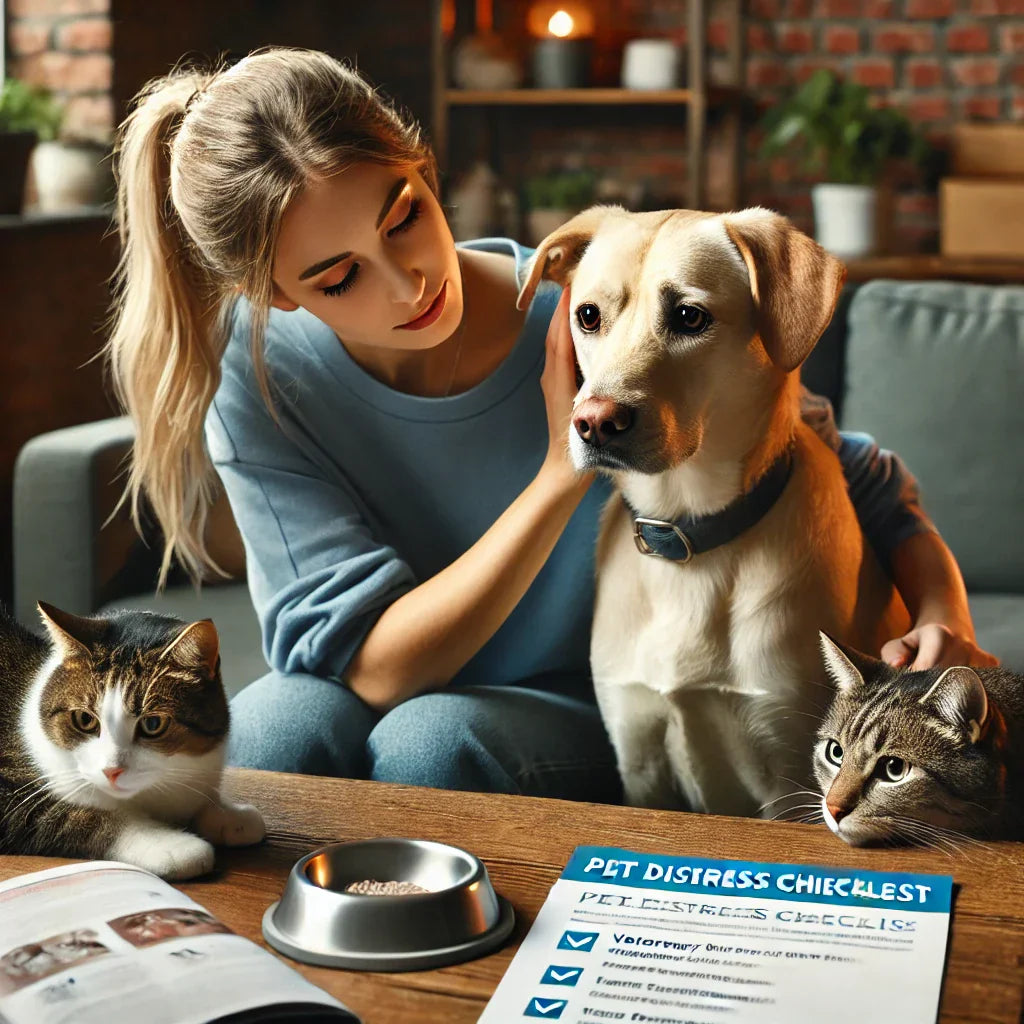
Recognizing Signs of Pet Distress and Saving Them in Time: A Complete Guide
Share

Introduction: Why Recognizing Pet Distress is Critical
Pets can’t communicate discomfort the way humans do, but subtle behavioral and physical changes often indicate stress, anxiety, or medical emergencies. Recognizing pet distress signs early can prevent serious health complications and even save lives.
What You’ll Learn in This Guide:
✔ Early behavioral and physical signs of pet distress
✔ Emergency actions to take for a distressed pet
✔ How to prevent pet stress with environmental adjustments
✔ When to seek veterinary intervention for pet emergencies
🐾 Identify distress signals early to prevent serious health issues—understanding symptoms helps in choosing the right treatment.
1. Common Behavioral & Physical Signs of Pet Distress
📌 How Do Pets Show Signs of Stress and Anxiety?
🚨 Behavioral Signs of Pet Stress:
✔ Sudden aggression or withdrawal – Changes in social behavior.
✔ Excessive vocalization – Unusual barking, whining, or yowling.
✔ Pacing or restlessness – Inability to settle in familiar environments.
✔ Hiding or excessive clinginess – Seeking isolation or staying unnaturally close.
✔ Excessive licking or chewing – Signs of self-soothing behaviors.
🚨 Physical Symptoms of Pet Distress:
✔ Panting or drooling excessively (without exercise or heat exposure).
✔ Loss of appetite or refusal to eat – Indicates stress or potential illness.
✔ Shaking, trembling, or excessive scratching.
✔ Unusual posture or limping – Possible pain or injury.
✔ Changes in bowel or urinary habits – Could signal anxiety or digestive issues.
🐾 Catch illnesses early with these warning signs—identifying distress early leads to faster recovery.
2. Immediate Actions to Take When a Pet Shows Signs of Distress
📌 What Should You Do When Your Pet is in Distress?
🚨 Step-by-Step Guide for Immediate Relief:
✔ Stay Calm: Pets sense their owner’s anxiety. Remain composed to avoid escalating their distress.
✔ Assess the Situation: Identify environmental stressors like loud noises, unfamiliar guests, or extreme temperatures.
✔ Remove Stressors: If possible, eliminate the trigger (e.g., move to a quieter space).
✔ Provide Comfort: Offer a safe, quiet space and speak in a calm tone.
✔ Apply Pet-Approved Calming Methods: Consider pheromone diffusers, anxiety wraps, or gentle petting.
✔ Check for Injuries or Illness: Observe any visible wounds, difficulty breathing, or extreme lethargy—these require immediate vet attention.
🐾 Recognizing Signs of Pet Distress and Saving Them in Time—knowing when to act quickly can save your pet’s life.
3. Emergency Pet Care: When to Seek Veterinary Help
📌 Which Signs of Distress Require Immediate Veterinary Attention?
🚨 Emergency Signs in Pets:
✔ Difficulty breathing or excessive coughing.
✔ Persistent vomiting, diarrhea, or blood in stool.
✔ Severe lethargy, collapse, or unresponsiveness.
✔ Uncontrolled shaking or seizures.
✔ Bloated abdomen (possible life-threatening condition in dogs).
✔ Signs of poisoning (foaming, drooling, difficulty walking).
📌 What to Do Before Reaching a Vet?
✔ For choking: Perform pet Heimlich maneuver if safe.
✔ For heatstroke: Move to shade, apply cool water, and offer small sips of water.
✔ For injuries: Apply gentle pressure to bleeding wounds and keep the pet still.
🐾 Master first aid techniques to handle pet emergencies at home—quick response prevents life-threatening situations.
4. Preventing Pet Distress: Proactive Care for a Happy Pet
📌 How Can You Reduce the Risk of Pet Stress?
🚨 Environmental Adjustments for Pet Well-Being:
✔ Create a Safe Space: Provide quiet areas where pets can retreat when feeling overwhelmed.
✔ Stick to a Routine: Predictability in feeding, exercise, and sleeping schedules reduces anxiety.
✔ Regular Exercise & Mental Stimulation: Helps release pent-up energy and promotes relaxation.
✔ Socialization Training: Introduce new environments and people gradually.
✔ Use Calming Aids: Pet-friendly essential oils, weighted blankets, or pheromone sprays can help.
🐾 Ensure your home is a safe space for your pet—proper setup minimizes stressors and improves quality of life.
5. Natural Remedies for Managing Pet Stress & Anxiety
📌 What Are the Best Natural Remedies for Pet Stress?
✔ Chamomile & Lavender: Natural relaxants (use diluted forms).
✔ CBD Oil: Helps manage anxiety and chronic pain.
✔ Valerian Root: Reduces nervousness and promotes relaxation.
✔ Probiotics & Digestive Enzymes: Support gut health, which impacts mood.
✔ Interactive Toys & Slow Feeders: Keeps pets engaged and prevents boredom-related stress.
📌 How to Use Natural Remedies Safely?
✔ Start with small doses and monitor for reactions.
✔ Consult a vet before adding new supplements or herbs.
✔ Never use essential oils directly on pets without dilution and vet approval.
🐾 Pair vaccinations with proper nutrition for optimal pet health—healthy pets are less likely to experience distress.
6. Step-by-Step Guide: What to Do If Your Pet is in Distress
📌 Quick Checklist for Pet Emergency Response:
🐾 Step 1: Stay Calm & Observe
✔ Remain calm and composed—pets react to your stress level.
✔ Look for changes in breathing, movement, or responsiveness.
🐾 Step 2: Assess the Environment
✔ Identify any immediate triggers (e.g., noise, unfamiliar people, extreme heat).
✔ Remove or adjust environmental factors if possible.
🐾 Step 3: Provide Immediate Comfort
✔ Speak softly, avoid sudden movements.
✔ Use a familiar blanket, toy, or safe space to help them feel secure.
🐾 Step 4: Take First Aid Actions (If Necessary)
✔ Apply pressure to wounds (for injuries).
✔ Administer Heimlich maneuver (if choking).
✔ Cool down a pet with heatstroke gradually.
🐾 Step 5: Contact a Veterinarian
✔ Seek emergency care if distress persists or worsens.
✔ Provide detailed symptoms and possible triggers to the vet.
🐾 Recognizing Signs of Pet Distress and Saving Them in Time—knowing these steps ensures faster recovery.
